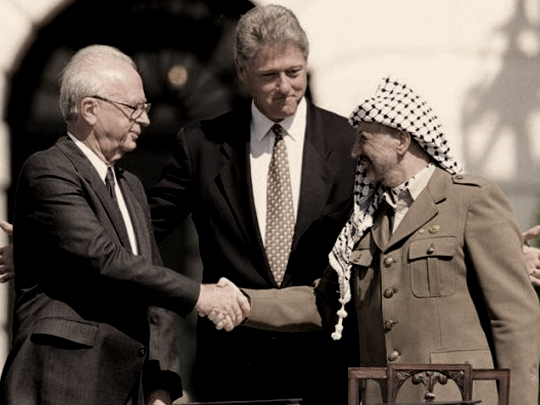IDF / Wikimedia Commons / CC-BY-SA-3.0 / GFDL
1 – The Oslo I Accord Signed Between Israel & Palestine
The Oslo I Accord was an effort to create a framework leading to the resolution of the ongoing Israeli–Palestinian conflict. It was the first face-to-face agreement between the Israeli government and the Palestine Liberation Organization (PLO).
Negotiations concerning the agreement were conducted secretly in Oslo, Norway, and completed on 20 August 1993.
The Accords were officially signed in Washington, D.C., on 13 September 1993, in the presence of PLO Chairman Yasser Arafat, Israeli Prime Minister Yitzhak Rabin and U.S. President Bill Clinton.
The documents themselves were signed by the PLO’s Mahmoud Abbas, Israeli Foreign Minister Shimon Peres, U.S. Secretary of State Warren Christopher and Russian Foreign Minister Andrei Kozyrev.
The Accord provided for the creation of the Palestinian National Authority, who would be responsible for the administration of the territory under its control.
The Accord also called for the withdrawal of the Israel Defense Forces from parts of the Gaza Strip and West Bank.
The Accord was seen as a stopgap arrangement that would last for a five-year period during which a permanent agreement could be negotiated. These future negotiations would see issues such as Jerusalem, Palestinian refugees, Israeli settlements, and borders discussed.
In a series of official Letters of Mutual Recognition, the PLO acknowledged the State of Israel and pledged to reject violence, while Israel recognized the PLO to be the representatives of the Palestinian people.
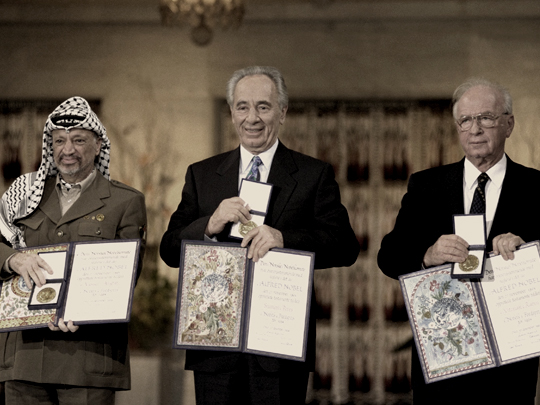
By Saar Yaacov / Wikimedia Commons / CC-BY-SA-3.0 / GFDL
As part of the Oslo I agreement, Yasser Arafat was allowed to return to the Occupied Palestinian Territories, after spending the previous decade in Tunisia.
On 28 September 1995, the Oslo II Accord was signed in Taba, Egypt, which was an Interim Agreement on the West Bank and the Gaza Strip. Neither Accord promised Palestinian statehood.
Israeli Prime Minister Yitzhak Rabin, Israeli Foreign Minister Shimon Peres, and PLO Chairman Yasser Arafat received the 1994 Nobel Peace Prize as a result of the signing of the Oslo Accords. Sadly, however, the Accords did not result in bringing peace to the Middle East.
2 – Battle of Mogadishu in Somalia
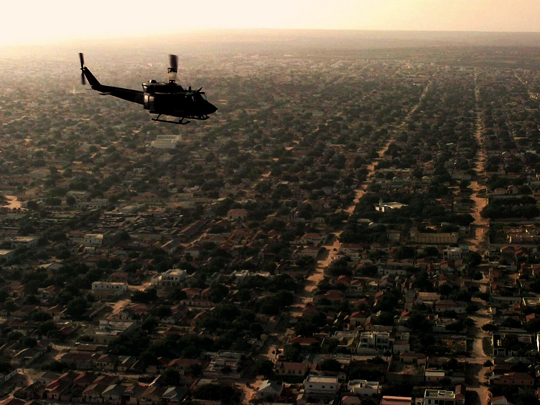
The Battle of Mogadishu was fought on 3–4 October 1993, in Mogadishu, Somalia, between United States forces and Somali militia loyal to the self-proclaimed president-to-be Mohamed Farrah Aidid.
Task Force Ranger, consisting of various elite special operations units from the U.S. Army, Air Force, and Navy, was dispatched to seize two of Aidid’s top lieutenants during a meeting in the Somali capital.
The objective of the operation was achieved as planned, however, conditions quickly spiraled out of control into what came to be known as the Battle of Mogadishu.
On 3 October 1993, the operation, intended to last an hour, developed into an urban battle after Somali militia shot down two Black Hawk helicopters shortly after the mission began.
Following an overnight standoff, a rescue operation took place early the next morning, when a combined task force, with soldiers from the Pakistan, Malaysian, and the U.S. Armies, was sent to rescue the trapped soldiers. They rescued the survivors from the first crash site.
However, the second crash site had been overrun by Somalis, where U.S. snipers Gary Gordon and Randy Shughart had volunteered to hold them off until ground forces arrived. A mob of thousands of Somali combatants and civilians eventually overpowered the two men.
The battle resulted in 18 deaths and 73 wounded among U.S. forces. One Pakistani and one Malaysian soldier were killed as part of the rescue mission. American pilot Michael Durant was taken prisoner after his Black Hawk crashed but was later released.
According to various sources, there were between 300 and 3,000 Somalians killed or injured, including civilians, in the battle. The events of the two days are depicted in the 2001 film Black Hawk Down.
3 – The Waco Siege
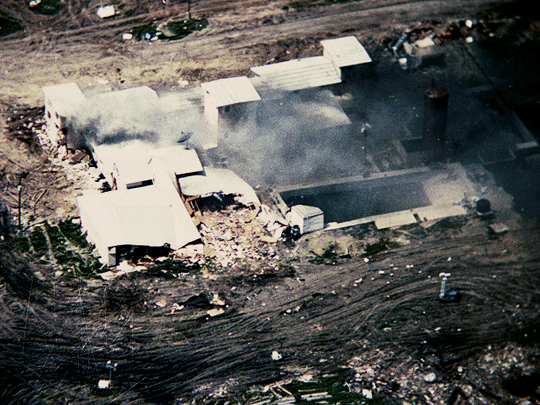
The Waco siege was the siege of a compound belonging to the Branch Davidians religious group, carried out by U.S. federal and state law enforcement and military between February 28 and April 19, 1993.
Led by David Koresh, the Branch Davidians were headquartered at Mount Carmel Center ranch in Axtell, Texas, about 13 miles from Waco.
The Bureau of Alcohol, Tobacco, and Firearms (ATF) obtained a search warrant and arrest warrants for Koresh and other group members, on suspicion of the group stockpiling illegal weapons.
When the ATF attempted to raid the ranch, a gun battle erupted, which saw four ATF agents and six Davidians killed during the initial two-hour firefight. Both sides claimed the other side fired first.
Following the gunfight, a siege was initiated by the FBI, which would last for 51 days. During the siege, 35 Branch Davidians left, before the FBI launched a tear gas attack to try and force the remaining Davidians out. During the attack, a fire engulfed the building.
Nine people left the building during the fire, with the remaining Branch Davidians, either dying from the effects of the fire or shot inside the building as a mercy killing.
Footage of the blaze was broadcast live by television crews, in which a total of 76 Branch Davidians died, including 28 children. The FBI concluded Koresh’s top aide, Steve Schneider, shot and killed Koresh, before killing himself.
The origin of the fire is a source of controversy, with an internal Justice Department investigation concluding that Branch Davidian members had started the fire, while Davidian survivors maintain the fires were either accidentally or deliberately started by the assault.
Nothing remains of the buildings today other than a concrete foundation, as the entire site was bulldozed two weeks after the siege ended. A small chapel, built years after the siege, stands on the site today.
4 – Notorious Colombian Drug Lord Pablo Escobar is Killed
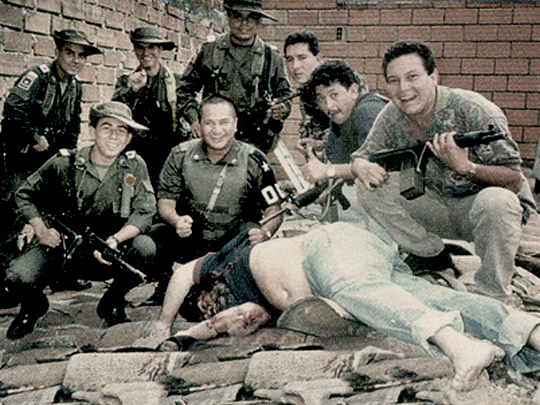
Escobar was a notorious Colombian drug lord who, at one time, was one of the wealthiest people in the world, with an estimated worth of $30 billion.
At the peak of his power, Escobar controlled over 80% of the cocaine being imported into the United States.
Escobar’s Medellín cartel was known for their ruthlessness and violence against anyone who got in their way.
Eventually, an escalation in bloodshed saw the public, who had seen him as a Robin Hood-type hero, largely turn against him and his gang.
In 1991, Escobar surrendered to Colombian authorities and was imprisoned in what became his own luxurious private prison, La Catedral, overlooking Medellín.
However, in July 1992, Escobar escaped La Catedral, which would result in Escobar spending the remainder of his life on the run. To keep his daughter warm, he is said to have burned over $1 million in cash while in hiding.
On 2 December 1993, sixteen months after his escape, Escobar died in a shootout after a Colombian electronic surveillance team tracked his radiotelephone transmissions and found him hiding in the Los Olivos barrio of Medellín.
The men attempted to escape, as a firefight ensued, by running across the roofs of adjoining houses to reach a back street, but both were shot and killed by Colombian National Police.
Escobar was shot in the leg, torso, and a fatal gunshot through his ear. He died the day after his 44th birthday. The Netflix series Narcos is based on his rise and fall from power.
5 – 10-Year-Olds Robert Thompson and Jon Venables Murder 2-Year-Old James Bulger
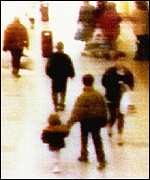
On 12 February 1993, 2-year-old James Bulger from Kirkby, Merseyside, England, was abducted, tortured and killed by Robert Thompson and Jon Venables, who were both ten-years-old at the time.
Bulger was abducted from a Shopping Centre as his mother had temporarily taken her eyes off him. CCTV footage shows the boys taking Bulger by the hand, before leading him on a 2.5-mile walk, during which he was dropped on his head and suffered facial injuries.
The subsequent investigation found the boys were seen by 38 people during their walk across Liverpool. Bulger was seen to be crying and had a bump on his forehead, but most bystanders did not question it.
When challenged by two people separately, Thompson and Venables claimed Bulger was their younger brother or that he was lost and they were taking him to the police station. Instead, they led Bulger to a railway line near a disused railway station, where they tortured him.
There, Bulger had blue modeling paint, which the boys had stolen, thrown into his left eye.
They stamped on him, threw bricks and stones at him, and placed batteries in his mouth, before finally dropping an iron bar on Bulger’s head, from which he sustained 10 skull fractures.
In total, Bulger suffered 42 injuries, before Thompson and Venables laid him across the railway tracks and weighted his head down with rubble. They had hoped that a train hitting him would make his death appear to be an accident.
After the two boys left the scene, Bulger’s body was cut in half by a train, before being discovered two days later. It was determined by a forensic pathologist, however, that Bulger had already died before being hit by the train.
The breakthrough in the case came when a woman recognized Venables from enhanced images of the two boys on television, and knew he had played truant with Thompson. On 20 February 1993, Thompson and Venables were charged with Bulger’s abduction and murder.
The pair were found guilty on 24 November 1993, making them the youngest convicted murderers in modern British history, both aged 11. They were sentenced to detention until a Parole Board decision in June 2001 recommended their release on a lifelong license.
In 2010, Venables was sent to prison for breaching the terms of his license and was released on parole again in 2013.
In November 2017, Venables was again sent to prison for possessing child abuse images on his computer.
6 – Downing Street Declaration Concerning Northern Ireland’s Self-Determination
The Downing Street Declaration was a joint declaration issued by the UK Prime Minister, John Major, and Republic of Ireland Taoiseach, Albert Reynolds, on 15 December 1993.
The declaration affirmed both the right of the people of Ireland to self-determination and that Northern Ireland would only be transferred to the Republic of Ireland from the United Kingdom if a majority of its population was in favor of such a move.
The declaration also included the principle of consent that the people of the island of Ireland, had the exclusive right to solve the issues between North and South by mutual consent.
This statement was critical to producing a positive change of attitude by Irish Republicans towards a negotiated settlement, and later became one of the points of the Good Friday Agreement.
It also pledged the governments to seek a peaceful constitutional settlement and promised that parties linked with paramilitaries, such as Sinn Féin, could take part in the talks, so long as they abandoned violence.
After a subsequent meeting between Sinn Féin President Gerry Adams and U.S. congressman Bruce Morrison, followed by a joint statement issued by Adams and John Hume, the Provisional Irish Republican Army announced a ceasefire on 31 August 1994.
Shortly after, on 13 October, the Combined Loyalist Military Command, an umbrella body for loyalist paramilitary groups in Northern Ireland, also announced a ceasefire.
7 – World Trade Center Bombing
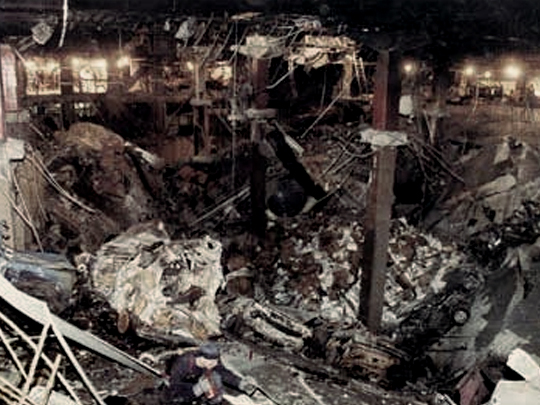
The 1993 World Trade Center bombing was a terrorist attack carried out on 26 February 1993.
A truck bomb was detonated at 12:17 pm in the underground garage of the North Tower of the World Trade Center in New York City.
The 1,336-pound explosive device was intended to send the North Tower crashing into the South Tower, bringing both towers collapsing down and killing tens of thousands of people in the process.
However, it failed to inflict damage to such a scale, but still killed six people, five Port Authority employees and a businessman whose car was in the parking garage, and injured over a thousand more.
The garage was severely damaged in the explosion, giving rise to the possibility that had the van been parked closer to the World Trade Center’s poured concrete foundations, the plan might have succeeded.
In March 1994, Mahmud Abouhalima, Mohammad Salameh, Nidal A. Ayyad, and Ahmed Ajaj were convicted of carrying out the bombing. Their charges included conspiracy and explosive destruction of property.
In November 1997, Ramzi Yousef, the mastermind behind the bombing, and Eyad Ismoil, the man who drove the truck carrying the bomb, were also convicted.
